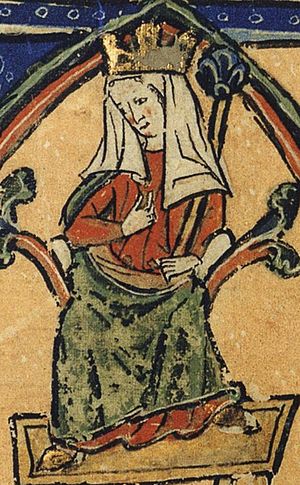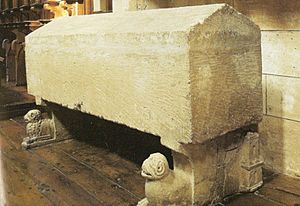Berengaria of Castile facts for kids
Quick facts for kids Berengaria |
|
|---|---|

Detail of the 13th-century cartulary of the Toxos Outos Monastery
|
|
| Queen of Castile and Toledo | |
| Reign | 6 June – 31 August 1217 |
| Predecessor | Henry I |
| Successor | Ferdinand III |
| Queen consort of León | |
| Tenure | 1197–1204 |
| Born | 1179 or 1180 Burgos |
| Died | 8 November 1246 (aged 66) Las Huelgas near Burgos |
| Burial | Las Huelgas near Burgos |
| Spouses |
|
| Issue more... |
Ferdinand III of Castile Alfonso, Lord of Molina Berengaria, Latin Empress |
| House | Castilian House of Ivrea |
| Father | Alfonso VIII of Castile |
| Mother | Eleanor of England |
| Religion | Roman Catholicism |
Berengaria (nicknamed the Great; 1179 or 1180 – 8 November 1246) was a powerful queen and advisor in medieval Spain. She was the Queen of Castile for a short time in 1217. Before that, she was the Queen of León from 1197 to 1204. She was married to King Alfonso IX of León.
Berengaria was the oldest child of King Alfonso VIII of Castile. This made her an important person to marry. She was first engaged to Conrad II, Duke of Swabia, a son of the Holy Roman Emperor. After he died, she married her cousin, Alfonso IX of León. This marriage helped keep peace between their kingdoms. They had five children together. Later, their marriage was ended by the Pope because they were too closely related.
When her father died, Berengaria became a regent (someone who rules for a young king) for her younger brother, Henry I of Castile. When Henry died unexpectedly, she became Queen of Castile. However, she quickly gave the throne to her son, Ferdinand III of Castile. She believed a man would be better at leading Castile's armies. Even so, she remained a very important advisor to her son. She helped him make big decisions and rule the country. She was key in bringing the kingdoms of Castile and León back together. She also supported his efforts to take back land from the Moors in what was called the Reconquista.
Contents
Early Life and First Engagement
Berengaria was born in Burgos around 1179 or 1180. Her parents were King Alfonso VIII of Castile and Eleanor of England. She was the oldest daughter. She had a brother named Henry I of Castile.
Because many of her younger brothers and sisters died young, Berengaria became the heir to the throne of Castile. This meant she was next in line to be queen. Because of this, many powerful families in Europe wanted her to marry their sons.
In 1187, Berengaria was engaged to Conrad II, Duke of Swabia. He was the son of the Holy Roman Emperor Frederick I Barbarossa. The marriage contract said that Berengaria would inherit Castile if her father or any childless brothers died. Conrad would only rule with her as her husband. Castile would not become part of the Holy Roman Empire.
The marriage never actually happened because Berengaria was very young, less than 10 years old. They never saw each other again. In 1191, Berengaria asked the Pope to end the engagement. Her grandmother, Eleanor of Aquitaine, likely encouraged this. Conrad was killed in 1196, which ended any chance of the marriage.
Queen of León
To help bring peace between Castile and León, Berengaria married King Alfonso IX of León in 1197. He was her first cousin once removed. As part of her marriage, she gained control over several castles and lands in León. These lands were mostly along the border with Castile. The nobles who managed these lands for her helped keep peace between the two kingdoms.
However, in 1198, Pope Innocent III said the marriage was not allowed. This was because Berengaria and Alfonso were too closely related. The Pope even threatened to remove Alfonso from the church. Despite this, they stayed together until 1204. They tried hard to get the Pope to allow their marriage. They also made sure their children were considered legitimate (rightful heirs).
The marriage was officially ended in 1204. Berengaria then returned to her parents in Castile. She focused on raising her children. Her children who survived were Ferdinand, Alfonso, and Berengaria.
After Being Queen of León
Even though she was no longer Queen of León, Berengaria still had power and could collect taxes from many lands there. She gave some of these lands, like Salamanca, to her son Ferdinand in 1206. Some nobles who had served her in León followed her to Castile.
The peace between León and Castile ended after her marriage was annulled. They went to war again, partly over her control of these lands. Treaties were made in 1205, 1207, and 1209. These treaties gave Berengaria and her son more control over important castles along the border. The 1207 treaty is important because it is the first public document written in the Castilian language.
In 1214, Berengaria's father, King Alfonso VIII, died. Her 10-year-old brother, Henry I of Castile, became king. Their mother, Eleanor, became the regent. But Eleanor died just 24 days later. Berengaria, being the next in line, took over as regent for her young brother.
However, powerful noble families, especially the House of Lara, caused trouble. They forced Berengaria to give up her role as regent and guardian of her brother to Count Álvaro Núñez de Lara.
In 1216, many important Castilian nobles met in Valladolid. With Berengaria's support, they agreed to work together against Álvaro Núñez de Lara. Berengaria felt unsafe and went to the castle of Autillo de Campos. She sent her son Ferdinand to his father's court for safety. Later that year, another meeting was held to prevent a civil war. But the disagreements continued, and several noble families broke away from Álvaro de Lara.
Queen of Castile
Things changed suddenly when her brother Henry I died on June 6, 1217. He was playing and was hit on the head by a loose tile. His guardian, Count Álvaro Núñez de Lara, tried to hide the news. But it was impossible to keep it a secret from Berengaria.
Berengaria knew that her former husband, Alfonso IX of León, might try to claim the throne for himself. He was her brother's closest male relative. So, she kept her brother's death and her own new role as queen a secret from Alfonso. She wrote to him, asking him to send Ferdinand to visit her.
Then, on August 31, 1217, Berengaria gave up her crown to her son, Ferdinand. She did this partly because she felt she could not be the military leader Castile needed at that time.
A Powerful Royal Advisor
Even though she was queen for only a short time, Berengaria remained a very important advisor to her son, King Ferdinand III. She helped him with state decisions. People at the time wrote that she still had a lot of influence over him.
For example, she arranged Ferdinand's marriage to Princess Elisabeth of Hohenstaufen (also known as Beatriz in Castile). Elisabeth was the daughter of Duke Philip of Swabia. The wedding took place in Burgos in 1219.
Berengaria also helped solve problems with the Lara family. In 1218, the Lara family tried to get King Alfonso IX of León (Ferdinand's father) to invade Castile and take his son's throne. But when Count Lara was captured, Berengaria stepped in. She helped her son and his father sign the Pact of Toro. This agreement ended the fighting between Castile and León.
In 1222, Berengaria helped her son again. She arranged a peace agreement with the Laras. She did this by arranging a marriage between her son Alfonso (Ferdinand's brother) and Mafalda, the daughter of a Lara lord.
She also arranged the marriage of her daughter Berengaria to John of Brienne in 1224. This move helped Ferdinand III get closer to the throne of León. Berengaria acted quickly to prevent her former husband's daughters from marrying someone who could claim the Leónese throne.
Perhaps her most important action for Ferdinand happened in 1230. King Alfonso IX of León died. He had named his daughters, Sancha and Dulce, as his heirs. This meant they would become queens of León, not Ferdinand. Berengaria met with their mother, Theresa of Portugal. She helped them agree to the Treaty of Las Tercerías. In this treaty, the daughters gave up their claim to the throne. In return, they received a lot of money and other benefits. This allowed the kingdoms of León and Castile to be reunited under Ferdinand III. They had been separated since 1157.
Berengaria also arranged Ferdinand's second marriage after his first wife died. She chose a French noblewoman, Joan of Dammartin. Berengaria served as regent again. She ruled Castile and León while her son Ferdinand was away fighting in the south during the Reconquista. Her skill in governing allowed him to focus on his campaigns.
Support for Learning and Her Legacy
Berengaria met with her son for the last time in 1245. She died on November 8, 1246. She was buried at Las Huelgas Monastery near Burgos.
Like her mother, Berengaria strongly supported religious places. She helped her mother support the Abbey of Santa María la Real de Las Huelgas. As Queen of León, she supported the Order of Santiago and the Basilica of San Isidoro. She gave money and made sure they didn't have to pay taxes.
Writers from her time described her as a wise and good woman. She was also interested in books and history. She asked Lucas de Tuy to write a history of the Kings of Castile and León. This book was meant to help future rulers. Berengaria herself was written about in the works of Rodrigo Jiménez de Rada and Juan of Osma.
See also
 In Spanish: Berenguela de Castilla para niños
In Spanish: Berenguela de Castilla para niños



